Visonic MCT423 Wireless Smoke Detector User Manual Inst instr new
Visonic Inc. Wireless Smoke Detector Inst instr new
Visonic >
8 pages
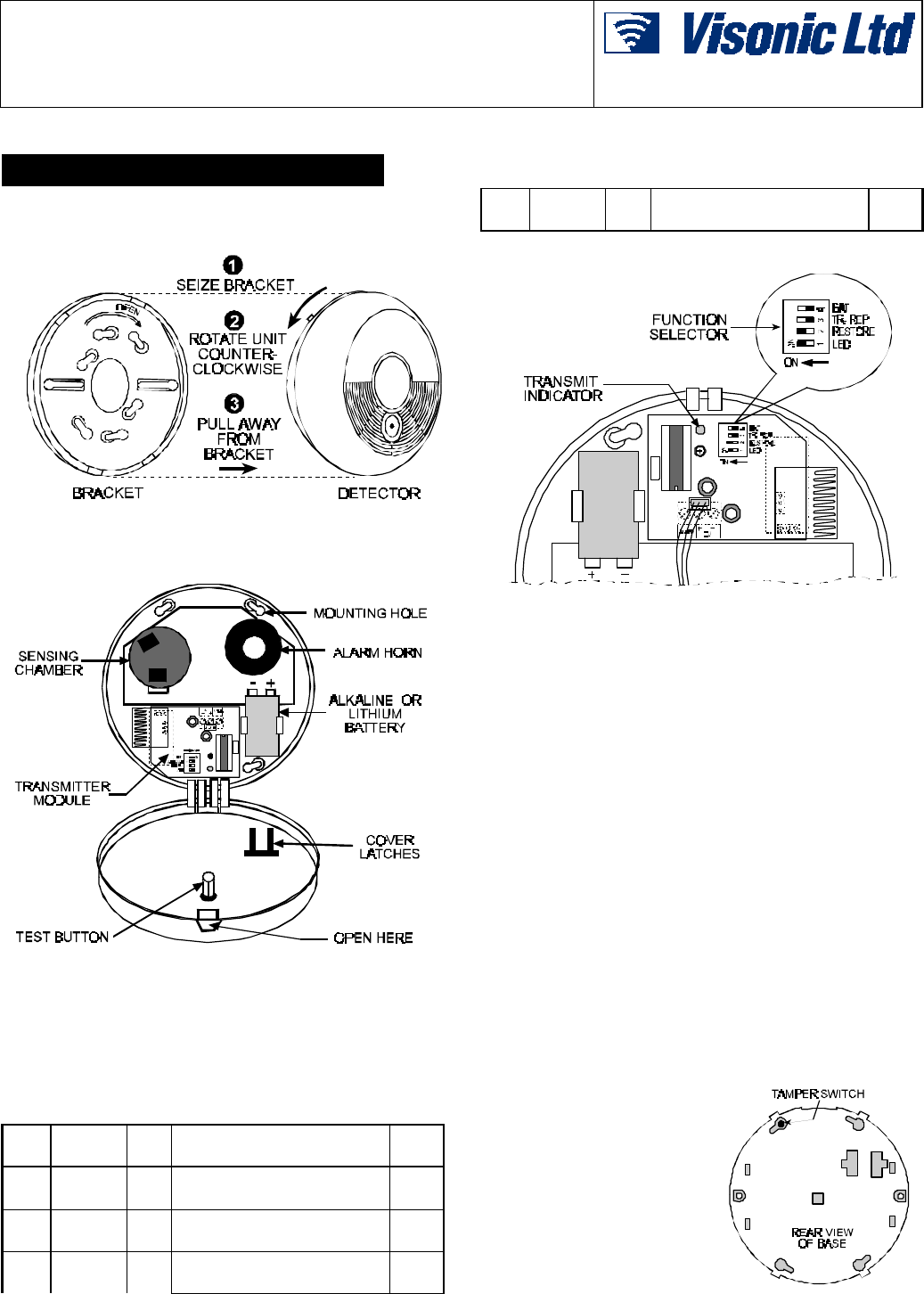
DE3640 1
MCT-423
Supervised Wireless PowerCode Smoke Detector
Installation Instructions
1. INSTALLATION SUMMARY
1.1 Disassembly
A. Separate the unit from its mounting bracket as shown in
Figure 1.
Figure 1. Separating the MCT-423 from its Bracket
B. Open the MCT-423 by pulling the cover away from the base
at the point indicated by “OPEN HERE” in Figure 2.
Figure 2. MCT-423 with Cover Swung Open
1.2 Setting the Function Switch
The MCT-423 has a 4-position DIP switch function selector (see
Figure 3). The switch levers are numbered 1 to 4, and each
switch allows you to select one of two options.
Open the cover and set the function switches as desired. The ON
position is indicated by the arrow near the switch body.
Table 1. Function selector settings
Sw- Marking Pos. Selected Option Defaul
t
SW-1 LED ON
OFF
LED will light upon transmission
LED is disabled
ON
SW-2
RESTORE
ON
OFF
“Restore” events reported
“Restore” events not reported
ON
SW-3 TR-REP ON
OFF
Alarm reported every 3 min.
Alarm reported only once
OFF
SW-4 BAT ON
OFF
Lithium battery is being used
Alkaline battery is being used
OFF
Note: Transmissions initiated by “tamper” events will be repeated
once every 3 minutes, regardless of SW-3 setting.
Figure 3. Transmit Indicator and Function Switch
1.3 Battery Connection and Initial Test
CAUTION: The MCT-423 comes with cover latches that will
prevent the cover from closing if there is no battery
inside.
The smoke detector is supplied with a 9V alkaline battery seated
within its holder but insulated from the battery terminals.
A. Pull the battery out and peel off the insulating material to
expose the terminals.
B. Match the battery terminals with the flexible contacts on the
detector PCB. Be sure to get the polarity right. If you
reverse the [+] and [–], the battery will discharge
completely within a very short time through the built in
protection diode!
C. When the terminals are properly matched, push the battery
firmly in until it is seated tightly within the holder.
Note: When the battery first makes contact with the detector,
the alarm horn may sound for one second. This indicates that
the battery is positioned properly.
D. Close the cover, then press the test button for about 5
seconds until the horn sounds two sequences of a loud 3-
beep alarm. This means that the smoke detection
section is working properly.
1.4 Resetting the Transmitter Module and Enrolling
its PowerCode ID
A tamper protection switch is
mounted on the transmitter
board. The tamper actuator,
extending through a hole in the
base (see Figure 4), is pressed
against the bracket when the
unit is attached to the bracket.
Removal of the unit from the
bracket will cause the switch
contacts to open, creating a
tamper event, which will be
reported by the transmitter to
the control panel.
Figure 4. Tamper Switch
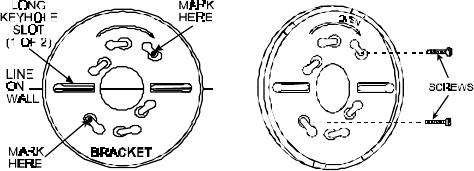
2 DE3640
Besides its tamper protection role, the tamper switch is
used to reset the transmitter at power up - this is
important for proper function of the unit.
To reset the transmitter and enroll its ID in the control panel’s
memory, proceed as follows:
A. Close the cover and turn the unit over, so that you can see
the back of the base.
B. Press the tamper switch once and release it. This will perform
the reset necessary for smooth transmitter power-up.
C. Refer to the control panel’s installation instructions and follow
the procedure given there for enrolling transmitter IDs. When
required to initiate a transmission for enrollment, press the
smoke detector’s test button until the built-in horn sounds.
Note: It is much easier to carry out this operation while holding
the MCT-423 in your hand, close to the control panel.
1.5 Mounting the Bracket in Place
Read Section 4 in this manual first, then decide where to install a
detector. Refer to Figures 5 and 6 and proceed as follows:
Figure 5. Aligning the Bracket
Figure 6. Mounting the
Bracket
1st.At the chosen location, draw a 15 cm (6”) long horizontal line.
2nd.Press the bracket against the mounting surface, aligning the
two longest keyhole slots with the line drawn in Step A. Mark
the drilling spots through two opposite keyhole slots.
C. Drill two 5 mm (3/16”) holes at the marked spots.
D. Attach the bracket to the wall, using the two screws and
plastic wall anchors (supplied).
1.6 Final Assembly and Test
1st. Before attaching the detector unit to the bracket, it is a good
practice to secure the cover to the base with two screws
(supplied with the unit) through the holes shown in Figure 7.
This will prevent unauthorized opening of the cover.
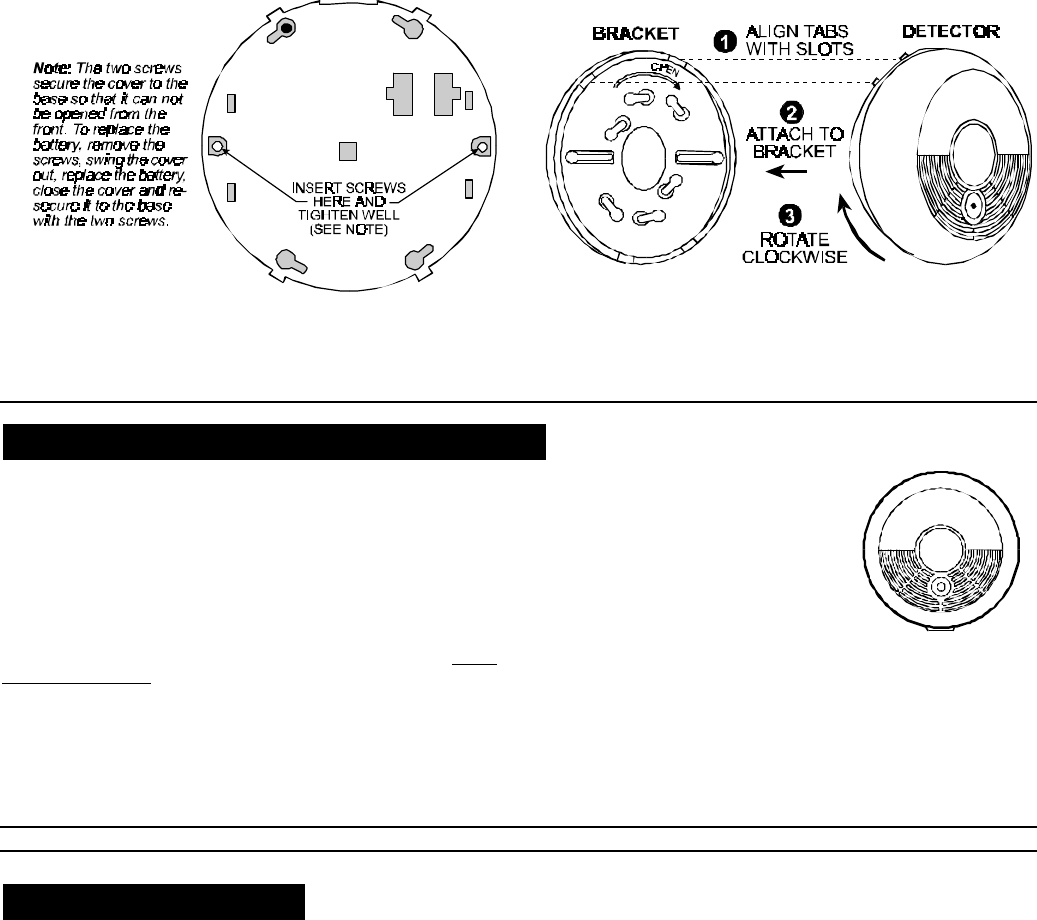
DE3640 1
Note: Unauthorized removal of the unit from the bracket will
initiate a tamper alert!
Figure 7. Securing the Cover to the Base
B. Press the test button until the built-in horn sounds. Verify that
the transmitted signal has been received at the control panel,
and that the control panel responds accordingly by activating
the fire alarm siren or any other warning device.
3rd. Attach the detector to the bracket as shown in Figure 8. Pull
outward to make sure that the detector is securely attached
to the bracket.
Figure 8. Final Assembly
2. DESCRIPTION AND APPLICATIONS
The MCT-423 is photoelectric smoke detector designed to sense
smoke, but not gas, heat or flame and fitted with a Power- Code-
type UHF transmitter. It provides early warning of developing fire
by sounding an alarm with its built-in alarm horn, and by
transmitting a coded alarm signal to a PowerCode receiver or to
a compatible wireless alarm control panel.
It must be borne in mind, though, that effective pre-warning of fire
accidents is only possible if the detector is located, installed and
maintained properly as described in this manual.
WARNING: This smoke detector is designed for use in a single
residential unit only, which means that it should be used inside a
single family home or apartment. It is not meant to be used in
lobbies, hallways, basements or another apartment in multi-family
buildings, unless there are already working detectors in each
family unit. Smoke detectors, placed in common areas outside
the individual living unit, such as on porches or in hallways, may
not provide early warning to residents. In multi-family buildings,
each family living unit should set up its own detector.
WARNING: This detector is not meant
to be used in non-residential
buildings. Warehouses, industrial or
commercial buildings and special
purpose non-residential buildings
require special fire detection and
alarm systems. This detector alone is
not a suitable substitute for complete
fire detection systems for places
where many people live or work, such
Figure 9. General View
as hotels or motels. The same is true of dormitories, hospitals,
nursing homes or group homes of any kind, even if they were
once single family homes. Please refer to NFPA 101, the Life
Safety Code, NFPA71, 72A, 72B, 72C, 72D and 72E for smoke
detector requirements for fire protection in buildings not defined
as "households".
WARNING: This detector, if used as a stand-alone unit, will not
alert people who are hard of hearing.
3. SPECIFICATIONS
SMOKE DETECTOR
Detection Sensitivity: 2.3 ±1.2 %/ft.
Alarm Sound Level: 85 dB at 3 m (10 feet)
Activity Indicator: LED in test button flashes once per 45 sec.
Audible Low Battery Warning: Built in horn beeps once a
minute for up to 30 days when the battery voltage drops.
TRANSMITTER AND CODING
Operating Frequency (MHz): 315, 418, 433.92, 868 or other
frequencies according to local requirements.
Transmitter's ID Code: 24-bit digital word, over 16 million
combinations, pulse width modulation.
Overall Message Length: 36 bits
Message Repetition: Repetitive transmission (once every 3
minutes) or one-shot, as selected with on-board DIP switch.
Supervision: Automatic signaling at 60-minute intervals.
Tamper Alerts: Tamper event (removal of the unit from its
bracket) is reported every 3 minutes, until the tamper switch is
restored.
Transmission Indicator: Red LED lights upon transmission
(visible only when the cover is open and Swith SW-4 set to ON).
ELECTRICAL DATA
Power Source: 9 Volt alkaline or lithium.
Current Drain: 28 µA standby, 20 mA in operation
Battery Life: At least one year
Battery Supervision: Automatic transmission of battery status
data as part of any transmitted message.
PHYSICAL DATA
Operating Temperature: 4.4°C to 37.8°C (40°F to 100°F).
Relative Humidity: 10% to 85%
Dimensions: 140 mm (5.5") x 45 mm (1.75")
Weight (including battery): 256 g (9 oz)
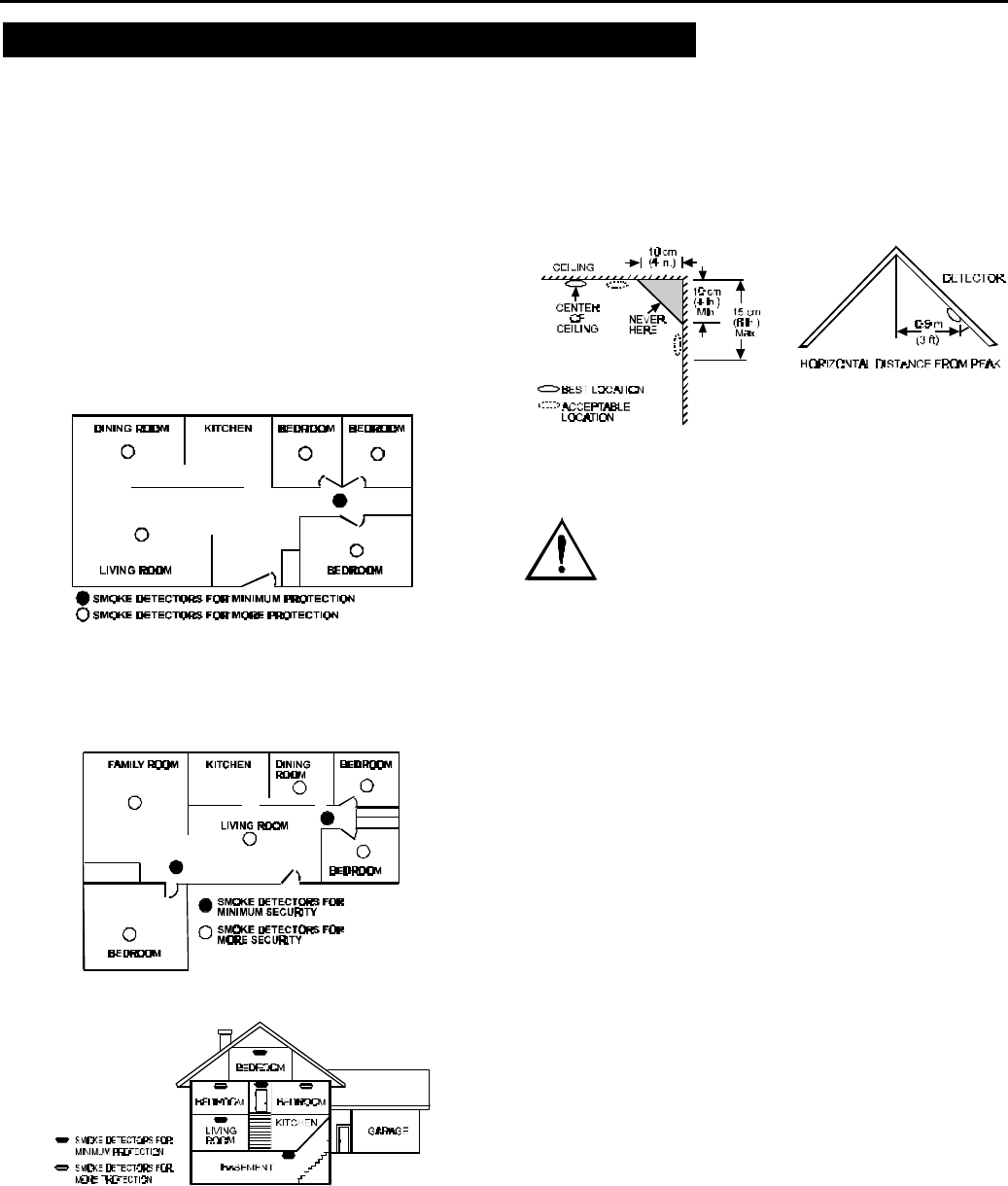
4 DE3640
4. SMOKE DETECTOR INSTALLATION OVERVIEW
4.1 Where to Install Smoke Detectors
Smoke detectors should be installed in accordance with the
NFPA Standard 74 (National Fire Protection Association,
Batterymarch Park, Quincy, MA 02169). For complete coverage
in residential units, smoke detectors should be installed in all
rooms, halls, storage areas, basements and attics in each family
living unit. Minimum coverage is one detector on each floor and
one in each sleeping area. Here are a few useful tips for you:
• Install a smoke detector in the hallway outside every separate
bedroom area, as in Figure 10. Two detectors are required in
homes with two bedroom areas, as in Figure 11.
• Install a smoke detector on every floor of a multi-floor home or
apartment, as shown in Figure 12.
• Install a minimum of two detectors in any household.
• Install a smoke detector inside every bedroom.
• Install smoke detectors at both ends of a bedroom hallway if
the hallway is more than 12 meters (40 feet) long.
Figure 10. Locations for placing smoke detectors in a single
residence with only one sleeping area
• Install a smoke detector inside every room where one sleeps
with the door partly or completely closed, since smoke could be
blocked by the closed door and a hallway alarm may not wake
up the sleeper if the door is closed.
Figure 11. Locations for Placing Smoke Detectors in Single-
Floor Residence with More than One Sleeping Area.
Figure 12. Placing Smoke Detectors in a Multi-Floor Residence
• Install basement detectors at the bottom of the basement
stairwell.
• Install second-floor detectors at the top of the first-to-second
floor stairwell.
• Be sure no door or other obstruction blocks the path of smoke
to the detector.
• Install additional detectors in your living room, dining room,
family room, attic, utility and storage rooms.
• Install smoke detectors as close to the center of the ceiling as
possible. If this is not practical, put the detector on the ceiling,
at least 10 cm (4 inches) away from any wall or corner, as
shown in Figure 13.
• If ceiling mounting is not possible and wall mounting is
permitted by your local and state codes, put wall-mounted
detectors between 10 - 15 cm (4 - 6 inches) from the ceiling,
also see Figure 13.
• If some of your rooms have sloped, peaked, or gabled ceilings,
try to mount detectors 0.9 meter (3 feet) measured horizontally
from the highest point of the ceiling as shown in Figure 14.
Figure 13. Recommended Best
and Acceptable Locations to
Mount Smoke Detectors
Figure 14. Recommended
Location to Mount Smoke
Detectors in Rooms with
Sloped, Gabled or Peaked
Ceiling
CAUTION (As required by the California State Fire
Marshall)
"Early warning fire detection is best achieved by the
installation of fire detection equipment in all rooms
and areas of the household as follows:
(1) A smoke detector installed in each separate sleeping area (in
the vicinity, but outside the bedrooms), and (2) Heat or smoke
detectors in the living rooms, dining rooms, bedrooms, kitchens,
hallways, attics, furnace rooms, closets, utility and storage rooms,
basements and attached garages."
For your information, NFPA Standard 74, Section 2-4 reads as
follows:
"2-4.1.1 Smoke detectors shall be installed outside each
separate sleeping area in the immediate vicinity of the bedrooms
and on each additional story of the family living unit including
basements and excluding crawl spaces and unfinished attics.
The provisions of 2-4.1.1 represent the minimum number of
detectors required by this standard. It is recommended that the
householder consider the use of additional smoke detectors for
increased protection for those areas separated by a door from
the areas protected by the required smoke detectors under 2-
4.1.1 above. The recommended additional areas are living room,
dining room, bedroom(s), kitchen, attic (finished or unfinished),
furnace rooms, utility room, basement, integral or attached
garage, and hallways not included in 2-4.1.1 above. However, the
use of additional detectors remains the option of the
householder." We
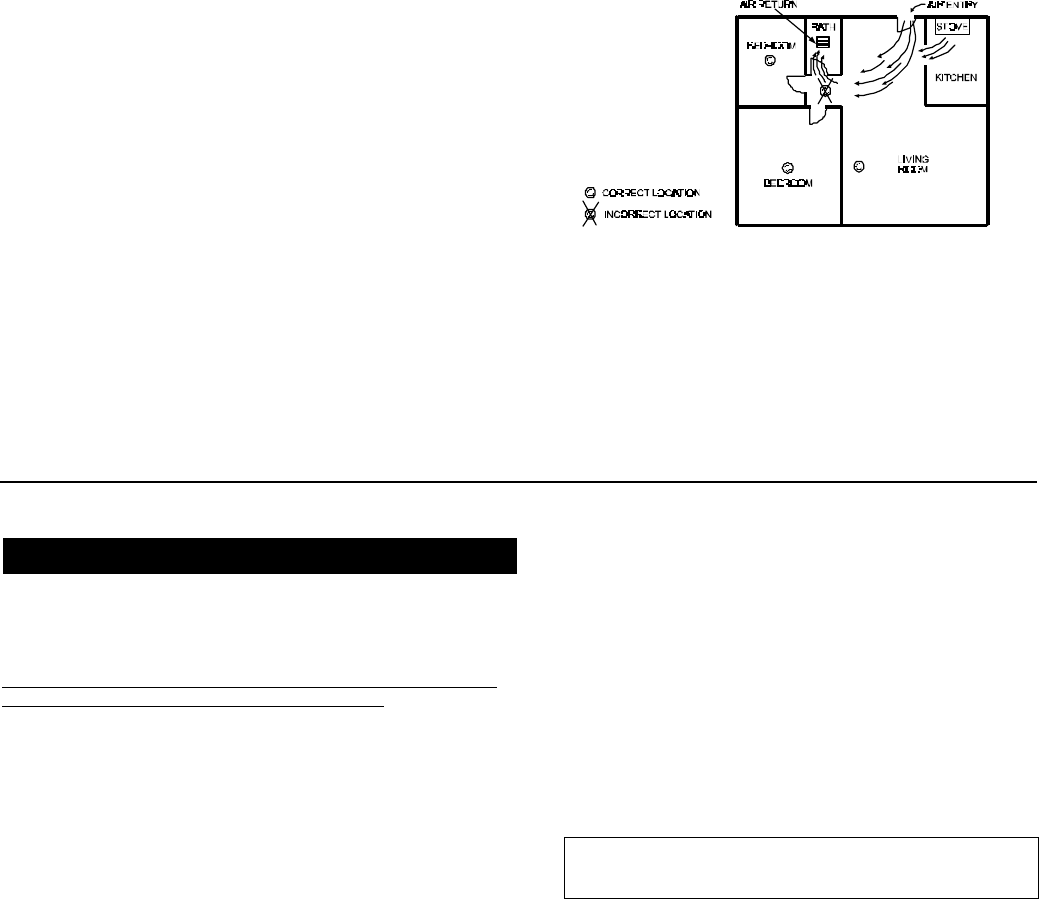
DE3640 5
recommend complete coverage and use of additional smoke
detectors.
4.2 Where to Install Smoke Detectors in Mobile
Homes and RVs
Mobile homes and RVs built after about 1978 were designed and
insulated to be energy-efficient. In mobile homes and RVs built
after 1978, smoke detectors should be installed as described
above. Older mobile homes and RVs may have little or no
insulation compared to current standards. Outside walls and
roofs are often made of non-insulated metal, which can transfer
thermal energy flow from outdoors. This makes the air right next
to them hotter or colder than the rest of the inside air. These
layers of hotter or colder air can keep smoke from reaching a
smoke detector. Therefore, install smoke detectors in such units
only on inside walls. Place them 10 ~ 15 cm (4 to 6 inches) from
the ceiling. If you are not sure how much insulation is in your
mobile home or RV, then install the detector on an inside wall. If
the walls or ceiling are unusually hot or cold, then install the
detector on an inside wall. Install one detector as close to the
sleeping area as possible for minimum security, or install one
detector in each room for more security. Before you install any
detector, please read the following section on "Where Not to
Install Smoke Detectors.”
4.3 Where Not to Install Smoke Detectors
False alarms occur when smoke detectors are installed where
they will not work properly. To avoid false alarms, do not install
smoke detectors in the following situations:
• Combustion particles are by-products of something burning.
Do not install smoke detectors in or near areas where
combustion particles are present, such as kitchens with few
windows or poor ventilation, garages where there may be
vehicle exhaust, near furnaces, hot water heaters and space
heaters.
• Do not install smoke detectors less than 6 meters (20 feet)
away from places where combustion particles are normally
present, like kitchens. If a 20-foot distance is not possible, e.g.
in a mobile home, try to install the detector as far away from
the combustion particles as possible, preferably on the wall. To
prevent false alarms, provide good ventilation in such places.
IMPORTANT: Never try to avoid false alarms by disabling the
detector.
• Do not mount smoke detectors in the path of fresh air intake.
The flow of fresh air in and out can drive smoke away from the
smoke detector; thus reducing its efficiency. Figure 15
indicates the correct and incorrect locations concerning this
problem.
• In damp or very humid areas or near bathrooms with showers.
Moisture in humid air can enter the sensing chamber, then
turns into droplets upon cooling, which can cause nuisance
alarms. Install smoke detectors at least 3 meters (10 feet) away
from bathrooms.
• In very cold or very hot areas, including unheated buildings or
outdoor rooms. If the temperature goes above or below the
operating range of smoke detector, it will not work properly.
The temperature range for your smoke detector is 4°C to 38°C
(40°F to 100°F).
• In very dusty or dirty areas, dirt and dust can build up on the
detector's sensing chamber, to make it overly sensitive.
Additionally, dust or dirt can block openings to the sensing
chamber and keep the detector from sensing smoke.
• Near fresh air vents or very drafty areas like air conditioners,
heaters or fans. Fresh air vents and drafts can drive smoke
away from smoke detectors.
• Dead air spaces are often at the top of a peaked roof, or in the
corners between ceilings and walls. Dead air may prevent
smoke from reaching a detector. See Figures 13 and 14 for
recommended mounting locations.
• In insect-infested areas. If insects enter a detector's sensing
chamber, they may cause a nuisance alarm. Where bugs are a
problem, get rid of them before putting up a detector.
• Near fluorescent lights, electrical "noise" from fluorescent lights
may cause nuisance alarms. Install smoke detectors at least
1.5 meters (5 feet) from such lights.
Figure 15. Recommended Smoke Detector Locations to Avoid Air
Streams with Combustion Particles
WARNING: Never remove batteries to stop a nuisance alarm.
Open a window or fan the air around the detector to get rid of the
smoke. The alarm will turn itself off when the smoke is gone. If
nuisance alarms persist, attempt to clean the detector as
described in this manual.
WARNING: Do not stand close to the detector when the alarm is
sounding. The alarm is loud in order to wake you in an
emergency. Too much exposure to the horn at close range may
be harmful to your hearing.
5. TAKING CARE OF THE MCT-423
5.1 Battery Replacement
The MCT-423 is designed to be as maintenance-free as
possible. To keep the smoke detector in good working order, you
must test it weekly, as instructed in Para. 6.1 below.
Make sure to test detectors mounted within RVs in storage before
each trip, and at least once each week during use.
Make it a rule to replace the detector’s battery once a year
even if there is no indication that the battery is weak. Also
be sure to replace it immediately upon reception of a low battery
message via your control panel.
If you disregard this message, an audible reminder in the
form of once-per-minute "beep" will sound after a few
days. The low-battery "beep" should last at least 30 days
before the battery dies out completely.
NOTE: For best performance, use only alkaline or lithium
batteries as replacement batteries. Carbon zinc batteries are not
acceptable. Alkaline batteries can be purchased at any retail
store that sells batteries. The following alkaline 9V batteries are
acceptable for proper operation: Eveready #522, #1222, #216;
Duracell #MN1604; or Gold Peak #1604P, #1604S.
Replace the battery as follows:
A. Grasp the detector’s body with your hands, rotate it slightly
counterclockwise and pull it off the wall-mounted bracket.
B. Turn the unit over and remove the two screws from behind
(see Figure 7).
C. Open the cover and remove the old battery. Put the new
battery in, paying close attention to correct polarity (see
Figures 2 and 3).
D. If you are installing a lithium battery, change the position of
Switch SW-4 from OFF to ON (see Figure 3 and Table 1).
WARNING! If you reverse the polarity, the unit will not
function and the battery will discharge completely
through the built-in protection diode!
E. Press the tamper switch once and release it (see Figure 4 for
switch location). This will perform the reset necessary for
smooth transmitter power-up.

6 DXXXX
F. Close the cover, re-insert the screws, and test the unit as
instructed in Para. 1.6B.
G. Re-insert the screws, tighten them well and re-mount the unit
on the bracket as instructed in Para. 1.6C.
5.2 Cleaning
Open the cover and vacuum the dust off the detector's sensing
chamber at least once a year. This can be done when you open
the detector to change the battery. Remove the battery before
cleaning. Use the soft brush attachment to your vacuum cleaner.
Carefully remove any dust on detector components, especially on
the openings of the sensing chamber.
Replace the battery after cleaning. Test the detector to make
sure that the battery is in correctly. Also make sure there is no
foreign matter inside the test button. Insert a toothpick from the
back to the front of the test button to remove any dust.
NOTE: If nuisance alarms keep occurring, check whether the
detector's location is adequate (see Para. 4.1 and 4.2). Relocate
the unit if it is not located properly. Clean as described above.
To clean the detector’s cover, first open the cover and remove
the battery. Hand-wash the cover with cloth dampened with clean
water. Dry it with lint-free cloth. Do not get any water on the
detector components. Replace the battery, and close the cover.
Test detector to make sure that battery works correctly.
6. ADDITIONAL ADVICE
6.1 Routine Testing
The detector should be tested weekly and also whenever you
suspect that it does not go into alarm. Push the test button firmly
with your finger until the horn sounds (it may take up to 20
seconds). Also verify that the control panel responds to the
transmitted fire alarm. If the detector fails, have it repaired or
replaced immediately, to ensure that it works properly.
WARNING: Never use an open flame of any kind to test
your detector. You may set fire to damage the detector as
well as your home. The built-in test switch accurately tests
all detector functions, as required by Underwriters'
Labora- tories. This is the only correct way to test the unit.
NOTE: If the alarm horn produces a loud continuous sound when
you are not testing the unit, this means the detector has sensed
smoke or combustion particles in the air. Verify that the alarm is a
result of a possible serious situation, which requires your
immediate attention.
• The alarm could be caused by a nuisance situation. Cooking
smoke or a dusty furnace, sometimes called "friendly fires" can
cause the alarm to sound. If this happens, open a window or
fan the air away to remove the smoke or dust. The alarm will
turn off as soon as the air is completely clear.
CAUTION: Do not disconnect the battery from the detector.
This will remove your protection from fires.
• If the alarm horn begins to beep once a minute, this signal
means that the detector's battery is weak. Install a new battery
immediately. Keep fresh batteries on hand for this purpose.
6.2 Tips to Enhance Your Protection From Fires
Putting up smoke detectors is only one step in protecting your
family from fires. You must also reduce the chances of fires
starting in your home. You must also increase your chances of
escaping safely if one does start. To have a good fire safety
program you must apply the following tips to enhance your
family's protection from fires:
1st.Install smoke detectors properly. Carefully follow all the
instructions in this manual. Keep your smoke detectors clean
and test them every week.
2nd.Remember that detectors that do not work will not alert you.
Replace your smoke detectors immediately if they are not
working properly.
3rd.Follow fire safety rules, and prevent hazardous situations:
• Use smoking materials properly. Never smoke in bed.
• Keep matches and cigarette lighters away from children.
• Store flammable materials in proper containers. Never use
them near open flame or sparks.
• Keep electrical appliances in good condition. Do not
overload electrical circuits.
• Keep stoves, fireplaces, chimneys, and barbecue grills
grease free. Make sure they are properly installed and
away from any combustible materials.
• Keep portable heaters and open flames such as candles
away from combustible materials.
• Do not allow rubbish to accumulate.
• Keep a supply of extra batteries on hand for your battery
powered smoke detectors.
D. Develop a family escape plan and practice it with your entire
family. Be sure to include small children in your practice.
• Draw a floor plan of your home, and find two ways to exit
from each room. There should be one way to get out of
each bedroom without opening the door.
• Explain to children what the smoke detector alarm signal
means. Teach them that they must be prepared to leave
the home by themselves if necessary. Show them how to
check to see if doors are hot before opening them. Show
them how to stay close to the floor and crawl if necessary.
Show them how to use the alternate exit if the door is hot
and should not be opened.
• Decide on a meeting place which has a safe distance from
your house. Make sure that all your children understand
that they should go and wait for you there if there is a fire.
• Hold fire drills at least every 6 months, making sure that
everyone, even small children, knows what to do to escape
safely.
• Know where to go to call the Fire Department outside your
home.
• Provide emergency equipment, such as fire extinguishers,
and teach your family to use this equipment properly.
6.3 More Tips on How to Face a Fire at Home
If you have made an escape plan and practiced it with your
family, their chances of escaping safelyare increased. Go over
the following rules with your children when you have fire drills.
This will help everyone remember the rules in a real emergency.
1st.Don't panic and stay calm. Your safe escape may depend on
thinking clearly and remembering what you have practiced.
2nd.Get out of the house as quickly as possible. Follow a
planned escape route. Do not stop to collect anything or to
get dressed.
3rd.Feel the doors to see if they are hot. If they are not, open
them carefully. Do not open a door if it is hot. Use an
alternate escape route.
4th.Stay close to the floor. Smoke and hot gases rise.
5th.Cover your nose and mouth with a wet or damp cloth. Take
short, shallow breaths.
6th.Keep doors and windows closed. Open them only if you have
to in order to escape.
7th.Meet at your planned meeting place after leaving the house.
8th.Call the Fire Department as soon as possible from outside
your house. Give the address and your name.
9th.Never go back inside a burning building. Contact your local
Fire Department. They will give you more ideas about how to
make your home safer from fires and how to plan your
family's escape.
The 315 MHz version of this device complies with Part 15 of the FCC Rules. Operation is subject to the following two conditions: (1) This

DE3640 7
device may not cause harmful interference, and (2) This device must accept any interference received, including interference that may
cause undesired operation.
WARNING! Changes or modifications to this unit not expressly approved by the party responsible for compliance could void the user's
authority to operate the equipment
The digital circuit of this device has been tested and found to comply with the limits for a Class B digital device, pursuant to Part 15 of the
FCC Rules. These limits are designed to provide reasonable protection against harmful interference in residential installations. This
equipment generates, uses and can radiate radio frequency energy and, if not installed and used in accordance with the instructions,
may cause harmful interference to radio and television reception. However, there is no guarantee that interference will not occur in a
particular installation. If this device does cause such interference, which can be verified by turning the device off and on, the user is
encouraged to eliminate the interference by one or more of the following measures:
– Re-orient or re-locate the receiving antenna.
– Increase the distance between the device and the receiver.
– Connect the device to an outlet on a circuit different from the one which supplies power to the receiver.
– Consult the dealer or an experienced radio/TV technician.
WARRANTY
Visonic Ltd. and/or its subsidiaries and its affiliates ("the Manufacturer") warrants its
products hereinafter referred to as "the Product" or "Products" to be in conformance
with its own plans and specifications and to be free of defects in materials and
workmanship under normal use and service for a period of twelve months from the
date of shipment by the Manufacturer. The Manufacturer's obligations shall be
limited within the warranty period, at its option, to repair or replace the product or
any part thereof. The Manufacturer shall not be responsible for dismantling and/or
reinstallation charges. To exercise the warranty the product must be returned to the
Manufacturer freight prepaid and insured.
This warranty does not apply in the following cases: improper installation, misuse,
failure to follow installation and operating instructions, alteration, abuse, accident or
tampering, and repair by anyone other than the Manufacturer.
This warranty is exclusive and expressly in lieu of all other warranties, obligations or
liabilities, whether written, oral, express or implied, including any warranty of
merchantability or fitness for a particular purpose, or otherwise. In no case shall the
Manufacturer be liable to anyone for any consequential or incidental damages for
breach of this warranty or any other warranties whatsoever, as aforesaid.
This warranty shall not be modified, varied or extended, and the Manufacturer does
not authorize any person to act on its behalf in the modification, variation or
extension of this warranty. This warranty shall apply to the Product only. All
products, accessories or attachments of others used in conjunction with the Product,
including batteries, shall be covered solely by their own warranty, if any. The
Manufacturer shall not be liable for any damage or loss whatsoever, whether directly,
indirectly, incidentally, consequentially or otherwise, caused by the malfunction of
the Product due to products, accessories, or attachments of others, including
batteries, used in conjunction with the Products.
The Manufacturer does not represent that its Product may not be compromised and/or
circumvented, or that the Product will prevent any death, personal and/or bodily
injury and/or damage to property resulting from burglary, robbery, fire or otherwise, or
that the Product will in all cases provide adequate warning or protection. User
understands that a properly installed and maintained alarm may only reduce the risk
of events such as burglary, robbery, and fire without warning, but it is not insurance
or a guarantee that such will not occur or that there will be no death, personal
damage and/or damage to property as a result.
The Manufacturer shall have no liability for any deat, personal and/or bodily
injury and/or damage to property or other loss whether direct, indirect, incidental,
consequential or otherwise, based on a claim that the Product failed to function.
However, if the Manufacturer is held liable, whether directly or indirectly, for any loss
or damage arising under this limited warranty or otherwise, regardless of cause or
origin, the Manufacturer's maximum liability shall not in any case exceed the
purchase price of the Product, which shall be fixed as liquidated damages and not
as a penalty, and shall be the complete and exclusive remedy against the
Manufacturer.
Warning: The user should follow the installation and operation instructions and
among other things test the Product and the whole system at least once a week. For
various reasons, including, but not limited to, changes in environmental conditions,
electric or electronic disruptions and tampering, the Product may not perform as
expected. The user is advised to take all necessary precautions for his/her safety
and the protection of his/her property.
6/91
VISONIC LTD. (ISRAEL): P.O.B 22020 TEL-AVIV 61220 ISRAEL. PHONE: (972-3) 645-6789, FAX: (972-3) 645-6788

8 DE3640
VISONIC INC. (U.S.A.): 10 NORTHWOOD DRIVE, BLOOMFIELD CT. 06002-1911. PHONE: (860) 243-0833, (800) 223-0020 FAX: (860) 242-8094
VISONIC LTD. (UK): UNIT 1, STRATTON PARK, DUNTON LANE, BIGGLESWADE, BEDS. SG18 8QS. PHONE: (01767) 600857 FAX: (01767)
601098
INTERNET: www.visonic.com
VISONIC LTD. 1999 MCT-423 DE3640- (REV. 0, 8/99)